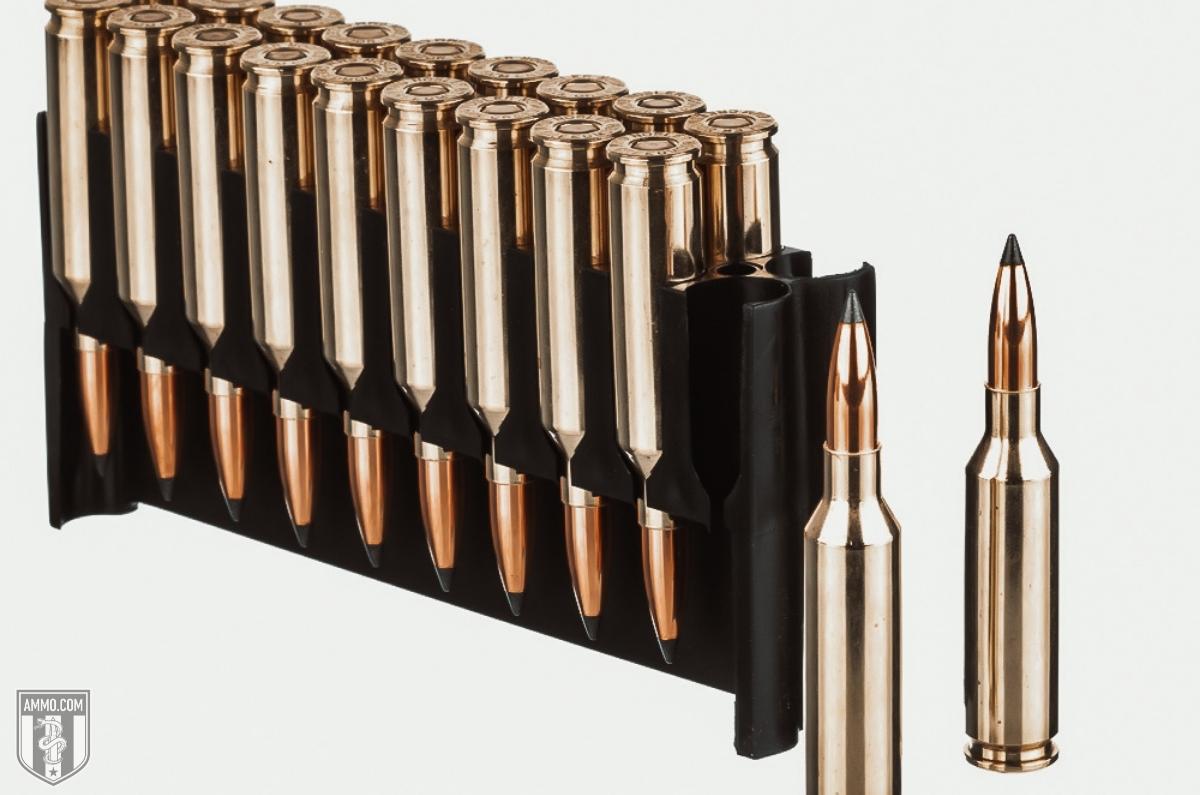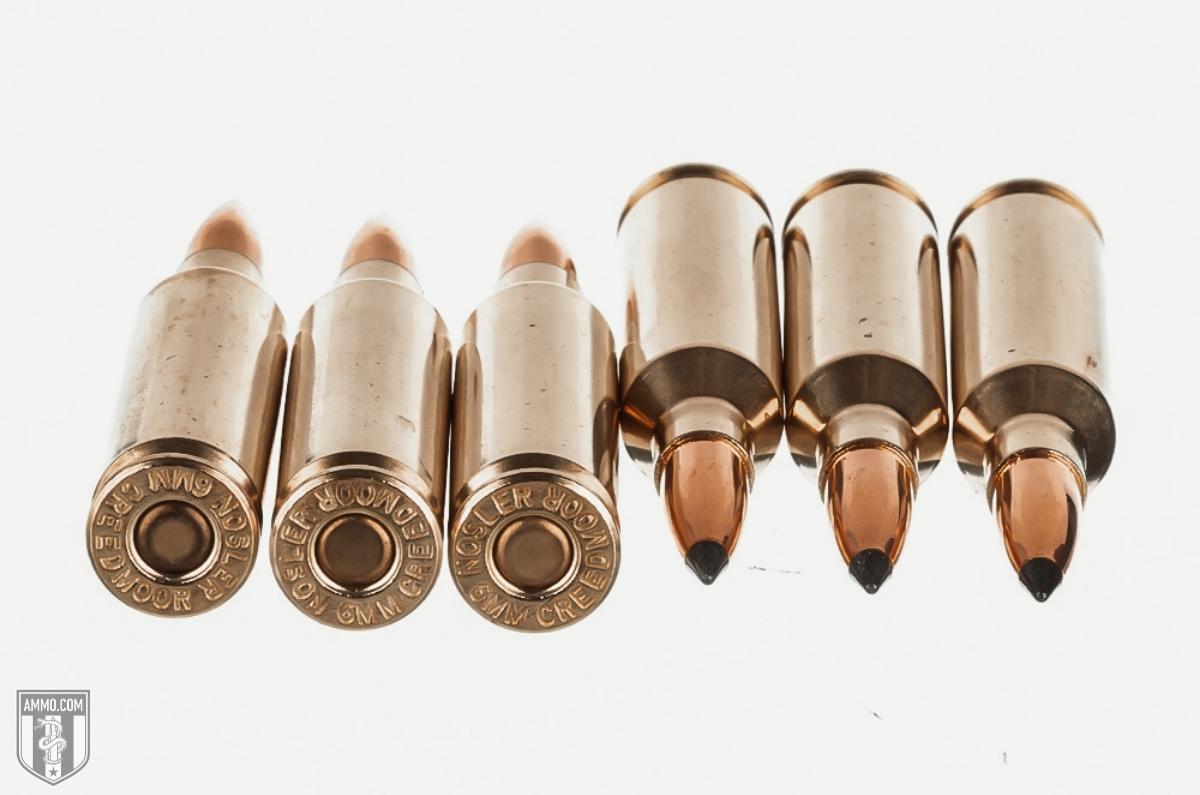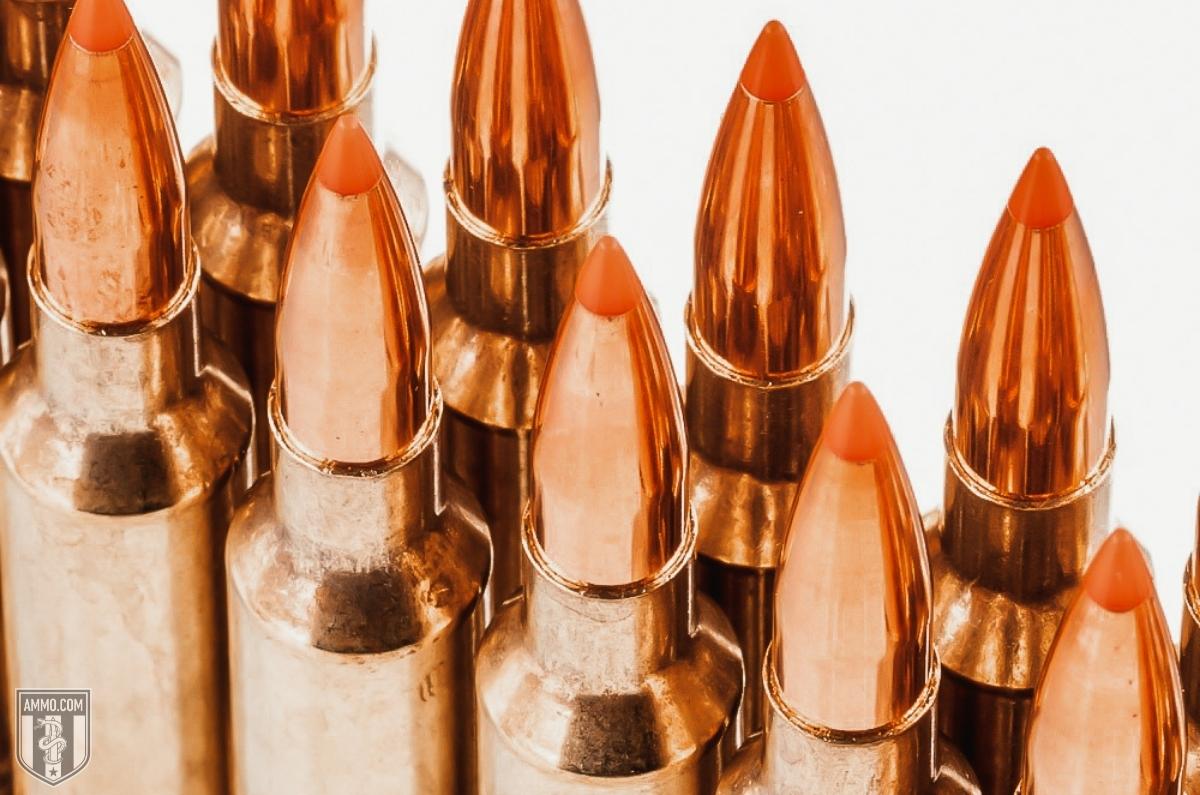6mm Creedmoor vs 6.5 Creedmoor: Clash of the Creedmoors
 The similarities between the 6mm Creedmoor (also 6mm CM or 6mm CRDMR) and 6.5 Creedmoor (also 6.5 CM or 6.5 CRDMR) don’t stop at the names. Both cartridges offer serious speed, accuracy, and long-range performance. Whether you’re weighing your options for championship rifle shooting or trying to choose a cartridge for long-range varmints or antelope, both of these Creedmoors should be top contenders.
The similarities between the 6mm Creedmoor (also 6mm CM or 6mm CRDMR) and 6.5 Creedmoor (also 6.5 CM or 6.5 CRDMR) don’t stop at the names. Both cartridges offer serious speed, accuracy, and long-range performance. Whether you’re weighing your options for championship rifle shooting or trying to choose a cartridge for long-range varmints or antelope, both of these Creedmoors should be top contenders.
While this article may not entirely settle the 6mm Creedmoor vs. 6.5 Creedmoor debate, it will definitely supply some crucial stats to help you make an informed decision.
You’ll want to bring along some sandbags and a spotting scope to this 6mm Creedmoor vs. 6.5 Creedmoor shootout, because these two cartridges are long-range superstars.
6mm Vs. 6.5 Creedmoor Comparison: A Battle of Bullet Size
Is 6mm Creedmoor the same as 6.5 Creedmoor? Despite the similarities in name, appearance, case proportions, and overall length, 6mm and 6.5 Creedmoor are two distinct cartridges.
The main difference between the two is bullet diameter. The 6mm cartridge shoots a 6mm (or .243-inch) bullet while the 6.5 Creedmoor uses a larger 6.5mm (or .264-inch) projectile.
Cartridge Specs: 6.5 Creedmoor Vs. 6mm Creedmoor
Understanding a cartridge’s capabilities always begins with basic knowledge of the physical properties of the cartridge. Here is a side-by-side look at the specs of these two Creedmoors.
As you can see, there are very few differences between the two Creedmoor cartridges. They have identical max loading pressures, similar overall length, and minimal variation in case capacity. The 6mm CM was even built using a necked-down 6.5 CM case.
The biggest difference between the two is bullet diameter. As the name implies, the 6.5 CM shoots a 6.5mm (or .264 caliber) projectile. In order for the 6mm Creedmoor cartridge to accept a smaller projectile, the 6.5 CM case was necked to shoot 6mm bullets (or .243-caliber).
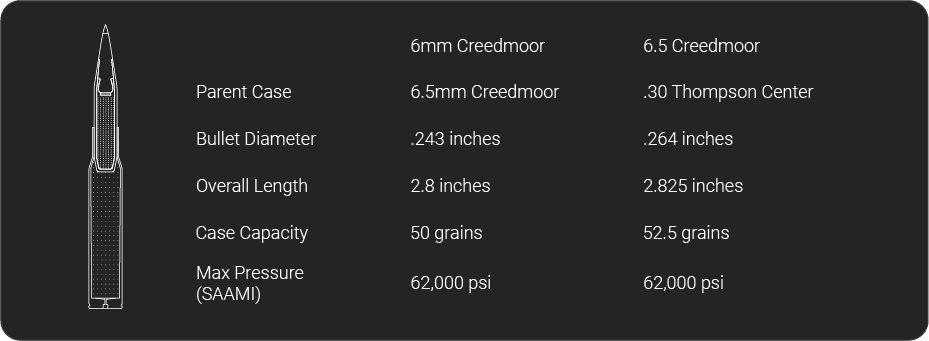
Recoil
While some shooters get high on big-bore cartridges with hefty recoil, even the toughest among them will shoot better with a milder recoiling rifle. Not only does a gentle cartridge make shooting (especially for extended periods) more enjoyable, but it also reduces shot recovery effort, allowing you to pull off faster, more accurate follow-up shots.
Both 6mm Creedmoor and 6.5 Creedmoor are well-known for their low recoil. Even recoil-sensitive shooters should have no trouble handling either Creedmoor, although the 6mm CM definitely produces less recoil and a softer shooting experience.
Recoil is affected by the weight of the rifle, the weight of the projectile, and its muzzle velocity. Actual recoil is a matter of physics and can be calculated using simple math. Here is a quick breakdown of the hard recoil numbers for each cartridge.
“Felt recoil,” or the shooter’s perception of recoil, is affected by a host of other less-measurable factors, including the shooter’s size and weight and whether the dimensions of the gun match the shooter’s body structure. Some shooters just seem to handle recoil better than others.

Velocity
When it comes to velocity, there is little difference between the two Creedmoors. They both come out of the muzzle cruising and continue cruising well past 500 yards. In fact, they both maintain supersonic velocities well beyond 1000 yards.

Accuracy/Trajectory
Both the 6.5 CM and the 6mm CM were engineered for precision long-range shooting. When shooting high-quality match-grade ammo through a well-maintained rifle held in skilled hands, both cartridges are capable of consistently producing sub ½-MOA groups.
When it comes to trajectory, the 6mm Creed has a slight edge over its predecessor. Because the 6mm cruises at a considerably faster velocity, it spends less time in the air on its way to the target. The higher velocity means both wind and gravity have less time to influence the bullet’s flight path.
The difference is especially notable at extreme distances. When we look at Hornady’s Match loads, there’s just over two inches difference in drop between the two cartridges at 500 yards. However, when we stretch targets out to 1000 yards, the 6mm drops an astonishing 32 inches less than 6.5 CM.
The flatter trajectory makes the 6mm Creedmoor the more forgiving cartridge, especially when shooting unknown distances, providing a bit of wiggle room in range estimation.
The flatter trajectory is also a godsend when engaging multiple targets at assorted distances because shooters can make smaller holdover corrections.
Ballistic Coefficient
For math- and physics-minded readers, ballistic coefficient (BC) is “the ratio of a bullet’s sectional density to its coefficient of form.”
For the rest of us, BC is basically a projectile’s ability to resist drag. High BC bullets are not only slower to shed velocity, but they also drop less over distance and carry more energy downrange than bullets with a low BC. Wind drift also affects high High BC projectiles less than those with lower BCs.
As the distance to targets stretches, poor BC becomes more pronounced. Shooters will see little difference at typical hunting ranges (within 300 yards). However, the difference in performance becomes more marked at extended ranges.
What do high BC bullets look like? Think long, slim, pointy, and built for speed.
The longer profile and thinner diameter of a 6mm bullet certainly give it a leg up in regards to ballistic coefficient. However, 6.5mm projectiles aren’t exactly BC slouches. Depending on the weight and bullet profile, some 6.5mm projectiles outclass the ballistic performance of some 6mms.
There’s a ton of complicated, high-level math involved in BC. To make things more confusing, velocity also has a major impact on ballistic performance.
To make life easier, we’ve compiled a brief look at the ballistic coefficients of some of Sierra’s most popular bullet designs. As you can see, there are wild variations in ballistic coefficients for the same cartridge.
When in doubt, most factory ammo lists the BC on the back of the box or on the manufacturer’s website.
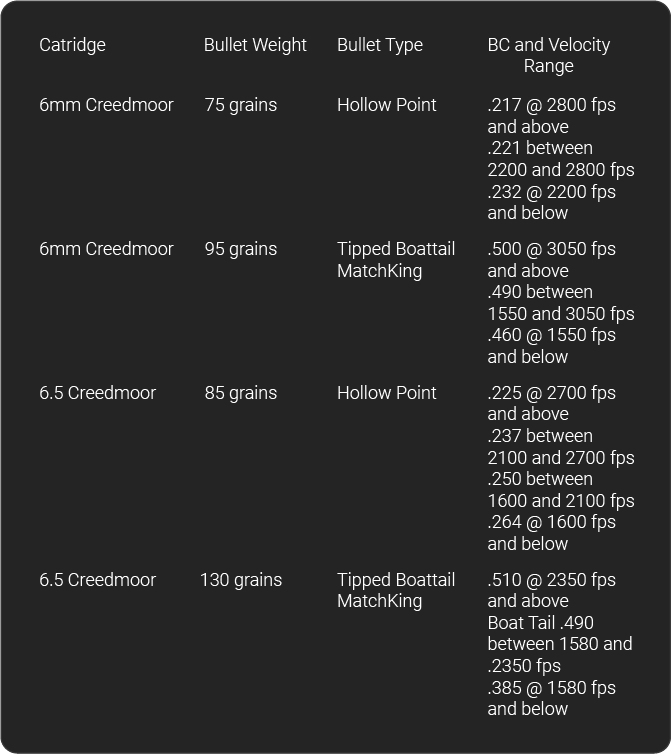
Kinetic Energy and Penetration
Although kinetic energy and penetration don't matter when you’re shooting paper or steel, they are incredibly important for hunters. It doesn’t matter how carefully you place your shot on a monster buck, if the bullet doesn’t have enough drive behind it to reach vital organs once it gets there, you’re probably going home empty-handed.
Make sure to load up on all the Hornady 6.5 Creedmoor ammo you'll need this hunting season to ensure you don't come home empty-handed!
The generally accepted standard for flattening whitetails and other similarly sized game animals is 1,000 foot-pounds of kinetic energy. Does that amount of energy guarantee a clean kill? Absolutely not. There are too many variables for any money-back guarantees in hunting. However, it’s a good starting place for determining effective terminal performance.
Larger animals require more terminal energy to get the bullet to deeper set vitals. Many elk hunters want at least 2000 foot-pounds at the animal.
Here's a quick breakdown of the terminal energy of Hornady’s popular Precision Hunter loads.
If we subscribe to the 1000 ft/lb rule for ethical hunting. Both cartridges are suitable for deer and antelope out to at least 500 yards.
If you have bull elk on your radar, stick to 6.5 CM and keep your shots within 200 yards.
Sectional Density
Kinetic energy is just one factor in how a bullet behaves once it reaches the target (also known as “terminal ballistics”). Although kinetic energy is what drives the bullet into the target, the bullet’s sectional density also affects the amount of tissue damage it can deliver.
Sectional density (SD) is the bullet’s weight divided by its diameter squared. Logically, longer bullets have higher sectional density and, generally speaking, the higher the number, the deeper the bullet will penetrate into the target.
For big game hunting, a bullet with an SD of at least .23 is recommended. When we crunch the numbers on Hornady’s Precision Hunter loads, 6.5 CM comes out on top with an SD of .29. The 6mm lags behind with a .249, confirming that the 6.5 CM is better suited for elk and other big game animals.
Hunting
Both Creedmoor cartridges were engineered to do one thing and do that one thing incredibly well - punch tight shot groups in paper targets. However, PRS culture often feeds the long-range hunting realm, mostly because so many precision competitors are also precision hunters.
While the hunting crowd that loudly cries “bigger is better” will scoff at both Creedmoors, the 6mm and 6.5 have plenty to offer deer hunters.
Not only are both Creedmoor cartridges stupid accurate, but the mild recoil that earned them favor among competition shooters also has its advantages in the field. Their soft-shooting performance helps eliminate flinch, allowing you to stay behind the scope and make faster, more accurate follow-up shots.
Both Creeds also retain long-distance velocity better than the 30-caliber gold standards of big game hunting.
Hunting With 6mm Creedmoor
Although 6mm projectiles are admittedly small, 6mm CM has serious potential as a hunting cartridge. Capable of driving the heaviest .243-caliber bullets nearly 100 fps faster than the.243 Win, 6mm CM is a seriously efficient option for varmint, pronghorn, and deer hunting.
Its lightning-fast speed also extends its effective range. With negligible bullet drop out to 300 yards, hunters won’t even need to compensate on most shots.
For larger, tougher game like elk and black bear, hunters will probably want a larger-caliber cartridge.
Are ethical big game kills possible with 6mm CM? Certainly. Especially on close-range shots with a perfect broadside presentation. However, perfect shot opportunities are rare in the hunting world.
Add in the scarcity of effective factory 6mm CM hunting loads, and toting your target rifle for backcountry bulls is a major gamble, especially if you aren’t rolling your own ammo.
Hunting With 6.5 Creedmoor
When it comes to hunting, 6.5 CM offers loads more versatility than its 6mm offspring. Federal offers the 6.5 CM topped with hunting bullets ranging from 95 grains to 140 grains. The 6.5 CM’s larger, heavier bullets generally produce larger wound channels and deeper penetration.
Its long-range potential, insane accuracy, and better-than-decent terminal ballistics have gained the 6.5 CM a dedicated fan base among deer hunters. However, this cartridge works best on game animals weighing under 400 pounds.
While plenty of hunters have harvested elk with their 6.5 CM, shot placement is critical. Wait for a good broadside shot. Those 6.5mm bullets are no match for a big bull’s shoulder blade.
Target/Competition Shooting
Both the Creedmoors were purpose-built for competition, and the number of PRS shooters running rifles chambered for these two cartridges speaks volumes about their long-range capabilities.
Which cartridge is best for PRS or other target competition shooting? That depends. The person behind the rifle will have far more effect on the outcome than whatever cartridge is in the chamber.
However, the effects of recoil in competition shooting definitely deserve more attention than it sometimes gets. Even the most skilled long-range shooters perform better with a rifle that is easy on the shoulder. While both Creedmoors fit the bill, the lighter recoil of the 6mm gives it a bit of an edge in the recoil department.
The 6mm’s flatter trajectory also makes it more forgiving when it comes to range estimation.
Ammo and Rifle Cost/Availability
Because 6.5 Creedmoor is the current darling among long-range hunters, there is a wide variety of factory loads and rifles for shooters to choose from. Unfortunately, there are only a handful of hunting-specific factory loads available for 6mm Creedmoor.
Most 6mm CM ammo is designed for shooting competitions like PRS, so if you want to shoot extreme ranges competitively, 6mm Creedmoor is the perfect tool for the job.
However, if you want a mild-recoiling 6mm rifle/cartridge combo for hunting, .243 Winchester is the safer bet. 6mm CM and .243 Win offer similar performance at standard hunting ranges, and there are far more factory hunting loads (and rifles) available for .243. .243 Winchester ammo is also significantly cheaper than most 6mm CM loads.
6.5 CM rifles are available in everything from AR-10s to traditional lever-actions, although bolt-action rifles are most common on the competition field.
Reloading
There’s plenty of good news for those interested in handloading 6mm and 6.5 CM ammo. When it comes to bullet selection, there is a wide variety of 6mm or 6.5mm to choose from.
If you want match-grade accuracy, look for HPBT MatchKings from Sierra or Hornady’s ELD-Match bullets (Extra Low Drag). Many serious competitors choose to hand load their competition ammo because it ensures precision accuracy and consistency.
Need game-dropping performance for your reloads? There are tons of options, including Hornady’s popular SST (Super Shock Tip) and Nosler’s famous Partition, both of which are available in a number of bullet weights.
If you need to start from scratch instead of reloading spent cases, there’s also plenty of 6.5 Creedmoor virgin brass on the market.
6mm Creedmoor cases are a little harder to come by. Lapua and Hornady are two of the few producing them. However, you can use a Redding Series C die to neck down premium 6.5 CM brass from Nosler, Starline, Norma, or other brass manufacturers.

6.5 Creedmoor Ballistics
Note: This information comes from the manufacturer and is for informational purposes only. The actual ballistics obtained with your firearm can vary considerably from the advertised ballistics. Also, ballistics can vary from lot to lot with the same brand and type load.
| 6.5mm Creedmoor Bullet WEIGHT | Muzzle VELOCITY (fps) | Muzzle ENERGY (ft. lbs.) | TRAJECTORY (in.) | |||||||||||
|---|---|---|---|---|---|---|---|---|---|---|---|---|---|---|
| Muzzle | 100 yds. | 200 yds. | 300 yds. | 400 yds. | Muzzle | 100 yds. | 200 yds. | 300 yds. | 400 yds. | 100 yds. | 200 yds. | 300 yds. | 400 yds. | |
| 120 Grain | 3020 | 2815 | 2619 | 2430 | 2251 | 2430 | 2111 | 1827 | 1574 | 1350 | 1.4 | 0 | -6.5 | -18.9 |
| 120 Grain | 3050 | 2850 | 2659 | 2476 | 2300 | 2479 | 2164 | 1884 | 1634 | 1310 | 1.4 | 0 | -6.3 | -18.3 |
| 129 Grain Superformance | 2950 | 2756 | 2570 | 2392 | 2221 | 2492 | 2175 | 1892 | 1639 | 1417 | 1.5 | 0 | -6.8 | -19.7 |
| 140 Grain | 2550 | 2380 | 2217 | 2060 | 1910 | 2021 | 1761 | 1527 | 1319 | 1134 | 2.3 | 0 | -9.4 | -27 |
| 140 Grain | 2710 | 2557 | 2410 | 2267 | 2129 | 2283 | 2033 | 1805 | 1598 | 1410 | 1.9 | 0 | -7.9 | -22.6 |
| 140 Grain | 2820 | 2654 | 2494 | 2339 | 2190 | 2472 | 2179 | 1915 | 1679 | 1467 | 1.7 | 0 | -7.2 | -20.6 |
6.5 Creedmoor Development/History
The 6.5 Creedmoor is the result of a collaboration between competitive shooter, Dennis DeMille, and David Emary, a former senior ballistician for Hornady. Their original goal was to engineer a single cartridge that could dominate targets across the course. They wanted something that offered precision accuracy on everything out to (and beyond) 1000 yards.
DeMille’s wish list for the cartridge included:
- Made from readily available components for easy replication by handloaders.
- Low recoil for rapid-fire strings.
- Magazine length dimensions.
- Would not shorten barrel life.
- A flat trajectory.
- High BC bullets.
Released by Hornady in 2007 and named for Creedmoor Sports, the 6.5 CM ticked off every single thing on the list.
The 6.5 CM cartridge is basically a .30 Thompson Center cartridge necked down to accept a 6.5mm projectile.
Since few shooters are familiar with the .30 Thompson Center, we’ll point out that the 6.5 CM is basically the ballistic twin of the .260 Remington. Both cartridges push 140-grain bullets within 100 fps of each other. Stand them side by side, and it’s also easy to mistake one for the other.
Soon after the cartridge’s release, Ruger introduced their Precision bolt action rifles chambered in 6.5 Creedmoor.
It took a few years for the 6.5 Creedmoor to gain traction. However, once it did, its popularity snowballed. Today, 6.5 CM rules the precision rifle series scene and has replaced .308 Winchester as the top choice among serious shooters.
The amount of 6.5 CM ammo sold each year also rivals popular hunting cartridges like .300 Win Mag and .375 H&H.
6mm Creedmoor Development/History
The 6mm Creedmoor is the brainchild of PRS competitor and outdoor columnist, John Snow. After the insane success of the 6.5 Creedmoor on the precision rifle scene, Snow kicked around the idea of necking down the cartridge to accept a smaller 6mm projectile. He experimented with some hand loads, had a custom rifle built for them, and then wrote about it for Outdoor Life.
Hornady, always looking for the next big step in cartridge innovation, saw Snow’s write-up and decided to run with it. The company released the first factory ammo shortly after Snow’s article ran in August 2010.
Ruger was also Johnny-on-the-spot and released their popular Precision Rifle chambered for the new 6mm Creedmoor.
Although the 6mm CM started out as a wildcat cartridge, with its insane long-range potential, it didn’t take long for its popularity to catch up to its parent cartridge. Today, the 6mm CM is the third most popular cartridge in the Precision Rifle Series, coming in just behind 6mm Dasher and 6.5 CM.
6mm Creedmoor Vs. 6.5 Creedmoor: Conclusion
If pinging steel or ripping targets at long-range turns you on, both Creedmoor cartridges should be on your radar. Honestly, the average shooter will have a hard time distinguishing the subtle differences in performance, especially on targets inside of 500 yards.
Side by side, the 6mm Creedmoor has less recoil than 6.5 with similar bullet speed and wind resistance. 6mm also has less energy than the 6.5 CM once it arrives at the target, a difference that should be a serious deal-breaker for hunters, especially those trying to stretch shots beyond 500 yards.
If you aren’t into handloading, the availability and variety of 6.5 CM ammo over 6mm could also be a major selling point for hunters and target shooters alike.
While it’s difficult to crown a clear winner in this 6mm vs. 6.5 Creedmoor showdown, we have to admit we lean heavily toward the 6.5 CM, especially if you want to use your rifle to punch holes in anything heavier than paper targets.
However, if you’re ultra recoil sensitive and aren’t all that interested in dropping big game, the 6mm CM handles like a lamb while ripping up long-range targets like a beast.
Ammo Comparisons
- .308 vs 5.56
- 6.5 Creedmoor vs .308
- .300 Blackout vs .308
- .300 Win Mag vs .308
- .243 vs .308
- .308 vs .30-06
- 7mm-08 vs .308
- .270 vs .308
- 7.62x39 vs .308
- .223 vs .308
- .338 Lapua vs .308
- .380 ACP vs 9mm
- .223 vs 5.56
- .300 Blackout vs 5.56
- 9mm vs 45 ACP
- 9mm vs 40 S&W
- .357 SIG vs 9mm
- 10mm vs 9mm
- 9mm vs 9mm Luger
- .243 vs .270
- .300 Win Mag vs .30-06
- .270 vs .30-06
- .40 vs .45
- 38 Special vs 357
- 9mm vs 40 vs 45
- 5.56 vs 7.62x39
- 338 Lapua vs .30-06
- .30-30 vs .30-06
- 300 PRC vs 338 Lapua
- .30-06 vs 7mm
- 300 Win Mag vs 338 Lapua
- 300 PRC vs 300 Win Mag
- 300 WSM vs 300 Win Mag
- 338 Win Mag vs 338 Lapua
- 12 Gauge vs 20 Gauge
- 10mm vs 357 Mag
- .30-30 vs 7.62x39
- 224 Valkyrie vs 22-250
- 17 HMR vs 22 Mag
- 7.62x39 vs .300 Blackout
- 45 ACP vs 45 Auto
- 45-70 vs 30-30
- 300 Blackout vs 223
- 357 Magnum vs 9mm
- 350 Legend vs 300 Blackout
- 224 Valkyrie vs 223
- 45 ACP vs 38 Super
- 6.5 Grendel vs .308
- 17 HMR vs 22 LR
- 10 Gauge vs 12 Gauge
- 22-250 vs 223
- 45 Colt vs 45 ACP
- 350 Legend vs 30-30
- 5.7x28 vs 223
- 5.7 vs 9mm
- 5.56 vs 5.7
- 22 vs 9mm
- Buckshot vs Birdshot
- 450 Bushmaster vs 308
- 450 Bushmaster vs 223
- Buckshot vs Slug
- 6.5 Grendel vs 5.56 vs 223
- 6mm ARC vs 6.5 Grendel
- 44 vs 45
- 458 SOCOM vs 5.56
- 357 vs 44
- 32 ACP vs 380
- 300 Win Mag vs 338 Win Mag vs 338 Lapua Mag
- 450 Bushmaster vs 458 SOCOM vs 50 Beowulf
- 6mm Creedmoor vs 6.5 Creedmoor
- TMJ vs FMJ
- 44 Special Vs 44 Magnum
- 45 90 vs 45 70
- 6.8 Western vs 6.8 SPC
- 50 Beowulf vs 50 BMG
- 26 Nosler vs 6.5 PRC
- 28 Gauge vs 410
- 6.8 SPC vs 5.56
- 6.8 SPC vs 6.5 Grendel
- 6.8 Western vs 7mm Rem Mag vs .28 Nosler
- 6.8 Western vs 6.5 Creedmoor
- 22 Hornet vs 223
- 6.8 Western vs 6.5 PRC
- .410 vs 12 Gauge
- .410 vs 20 Gauge
- 22 LR vs 22 Mag
- 6mm ARC vs 243
- 7mm-08 vs 270
- 243 vs 6.5 Creedmoor
- Nickel vs Brass Casing
- 204 Ruger vs 223
- 50 Beowulf vs 5.56
- 260 Remington vs 6.5 Creedmoor
- 6mm Remington vs 243
- 28 Nosler vs 300 PRC
- 50 Beowulf vs 50 AE
- 22 Nosler vs 22-250
- 450 Marlin vs 45-70
- 300 Win Mag vs 300 Norma
- 458 SOCOM vs 300 Blackout
- 38-55 vs 45-70
- 22 Hornet vs 22 LR
- 300 Norma vs 338 Lapua
- 338 Lapua vs 50 BMG
- 28 Nosler vs 300 Win Mag
- 28 Nosler vs 6.5 Creedmoor
- 204 vs 22-250
- 458 SOCOM vs 45 70
- 44 40 vs 45 70
- 6.8 SPC vs 6.5 Creedmoor
- 450 Bushmaster vs 30-06
- 7mm Rem Mag vs 300 Win Mag
- 30 Carbine vs 223
- 25-06 vs 30-06
- 26 Nosler vs 28 Nosler
- 16ga vs 12ga
- 30 06 vs 7.62 x54R
- 9mm Makarov vs 9mm Luger
- 350 Legend vs 223
- 30 Carbine vs 5.56
- 6.5x55 vs 6.5 Creedmoor
- 6.5 Creedmoor vs 270 vs 25-06
- M193 vs M855
- 450 Bushmaster vs 458 SOCOM
- 6.5 Grendel vs 6.5 Creedmoor
- 350 Legend vs 5.56
- .277 Fury vs 6.8 SPC
- 277 Fury vs 300 Win Mag
- 10mm vs .45 ACP
- 277 Fury vs 223
- 6.8 SPC vs 300 Blackout
- 6.5 PRC vs 6.5 Creedmoor
- 277 Fury vs 308
- 277 Fury vs 6.5 Creedmoor
- 350 Legend vs 450 Bushmaster
- 277 Fury Vs 5.56 NATO
- 10mm vs 40S&W
- 32 ACP vs 9mm
- 32 Special vs 9mm
- 8.6 Blackout vs 300 Blackout
- 30 Super Carry vs. 9mm
- 5.56 vs 9mm
- .50 Action Express vs 9mm
- 7.62x25 vs. 9mm
- 10mm vs 44 Magnum
- 300 Blackout vs 300 Win Mag
- 6.5 Grendel vs 300 Blackout
- 460 Rowland vs 10mm
- 300 RUM vs 300 PRC
- 300 Norma vs 300 PRC
- 45 GAP vs 45 ACP
- 7mm PRC vs 300 Win Mag
- 300 PRC vs 6.5 Creedmoor
- 300 PRC vs 308
- 357 SIG vs 357 Mag
- 7.62x39 vs 7.62x51
- 243 Win vs 223 Rem
